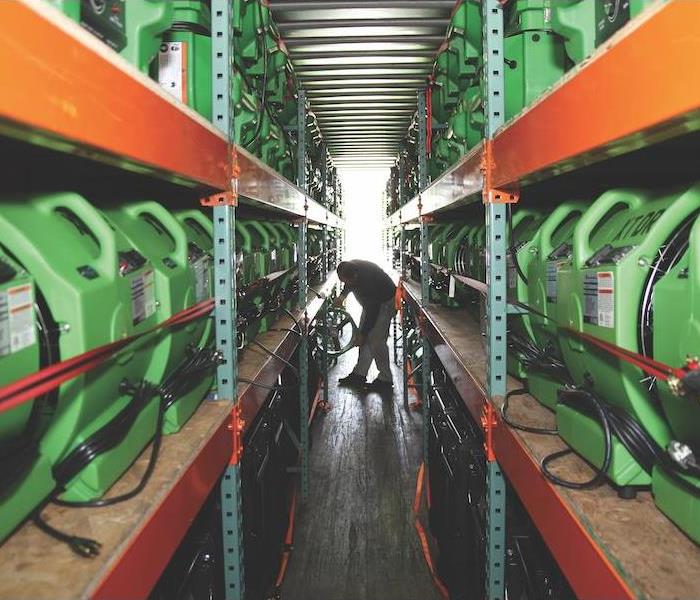Is it Possible to Dry Soaking Materials in the Home?
10/28/2020 (Permalink)
 SERVPRO has the experienced technicians with the equipment and expertise your home needs after a water catastrophe. Give us a call right away.
SERVPRO has the experienced technicians with the equipment and expertise your home needs after a water catastrophe. Give us a call right away.
SERVPRO Flood Damage Restoration Technicians Use Scientific Process to Dry your Portsmouth Home after a Flooding Disaster.
What is the science behind drying a wet home?
Flooding in your Portsmouth home can quickly lead to full or partial submersion of your belongings and structure. While these traumatic events can wreck a property, professional water restoration technicians (WRT) can often leverage psychrometry to quickly dry out your home. Psychrometry is a science that relates to the balance of air, humidity, or temperature and how these elements affect materials in the house. Large quantities of water in an indoor environment can unbalance the natural psychrometry of your home. Using water restoration equipment, we can leverage this science to ensure your home dries quickly and that materials return to a preloss condition. Creating a dry indoor air through dehumidification can help draw water out of soaking materials and belongings.
How does water intrusion affect materials in the home?
There are two main ways that flood damage affects your Portsmouth home. The first is direct liquid contact, while the second can be from water vapor- or water in the air. Liquid moisture is most likely to cause damages to the floors and lower walls of your home. In some instances, such as natural disasters, the soil around wall joints can loosen, which could affect the structural integrity of your home. Water vapor can also cause harm to ceilings and wall cavities through transfusion and condensation. Drying a property with the minimum amount of losses involves pumping out liquid water, evaporating residual moisture, and controlling water vapors from evaporated moisture. Balancing these psychrometric elements is essential to assure an efficient and correct flood restoration.
How does temperature affect water vapor?
- Air can hold more water when it is hot and less water when it is cold. But using temperature can increase the relative humidity in the home.
- When the air becomes saturated with moisture, it can no longer take any more water vapor, slowing down the speed of evaporation for wet materials.
- The relative humidity is a percentage that tells technicians how saturated the air is with moisture in a flooded property and is read with a Thermo hygrometer.
Why is relative humidity important to drying times?
Drying wet materials or belongings in your home relies on evaporating moisture. When relative humidity reaches 100%, the indoor air can no longer absorb water, which, in turn, slows down the evaporation process. Increasing the temperature by deploying portable furnaces or heaters in the affected area can reduce the relative humidity and ensure more water evaporates. Temperatures of up to 90 degrees can contain over 200 grains of moisture per pound (GPP.) Most of our drying equipment utilizes temperature to increase the efficiency of drying your home. Air-movers and water extractors both employ a heating element. Simultaneously, technicians can also create smaller drying chambers to make sure air is as warm as possible and evaporate floodwaters from the property quickly. Our technicians regularly monitor humidity to make sure that drying your home is as efficient as possible.
What is the difference between relative and specific humidity?
- Relative humidity works out a ratio for how much moisture is in the air. However, these ratios are dependent on the temperature, which can vary.
- Specific humidity is a reading of the actual grains of moisture per pound written as GPP.
- Specific humidity is a useful measurement for how quickly the structure of materials in your home is drying and the effectiveness of dehumidification.
How does specific humidity relate to fast-drying?
When a flood occurs in your property, massive amounts of water begin to soak into materials and often penetrate below the surface level- especially for porous materials. Incomplete or partial drying of your home can lead to further issues such as microbial growth or long-term water damage. To dry a house completely, our technicians need to know the specific humidity. By taking regular measurements, we can understand the effectiveness of our drying strategy. In practice, SERVPRO technicians take readings from an indoor environment and the exhausts of our dehumidifiers. The readings from the exhausted air of a dehumidifier should be much lower than those in the indoor environment. We can use the readings to either deploy more or fewer dehumidifiers in the property and assure your home can return to its preloss condition as quickly as possible.
How do psychrometric readings allow technicians to predict drying times?
- Having two measurements allows technicians to use a psychrometric chart to determine all other measures.
- Using a chart, we can control the dew point and vapor pressure in a flooded property to allow mitigation of loss.
- Combining our measurements with material permeance can help us provide homeowners with accurate predictions on the drying time-frame.
Drying a flooded property is an exact science that can be practically applied to prevent further losses in your home. Contact SERVPRO of The Seacoast, SERVPRO of Dover-Rochester, and SERVPRO of Durham at (603) 433-4300.






 24/7 Emergency Service
24/7 Emergency Service